A Growing Sense of National Identity
Published in 18th–19th - Century History, 20th-century / Contemporary History, Features, Issue 1 (Spring 2000), Volume 8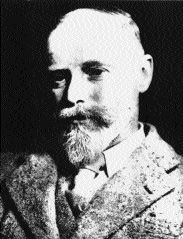
Early in the twentieth century Sir Hugh Lane indicated that Ireland needed a school of painters prepared to commit themselves to the expression of Irish art, in order to convey a growing sense of national consciousness. This search for a new identity, not solely confined to artists, occurred about the time of the 1916 Easter Rising and continued through to the emergence of the Irish Free State in 1922. In turning to the West of Ireland, artists, writers and politicians claimed to have discovered a people and landscape which retained a continuity with its Gaelic past, and also provided a source of new material from which to forge an Irish identity. Since the late nineteenth century artists had become increasingly attracted by the landscape and lifestyle of the West of Ireland because they felt it reflected a relatively unchanged pattern of life linked to an ancient Celtic era. Apparently untouched by progress or political turmoil, people lived in close communities, led primitive lifestyles and preserved customs and traditions from generation to generation. These people spoke Irish, wore practical homespun costumes and harvested their own food. Artists discovered that by using imagery associated with the West in a new and inventive manner, they were able to develop a body of work that looked distinctively Irish. The visual embodiment of this new sense of national consciousness was marked by writers and artists in Saorstát Éireann the Irish Free State Official Handbook, published in 1932, recording the first decade of national freedom and promoted by successive Irish governments.
A pattern of works
Dancing at a Northern Crossroads (front cover) by Charles Lamb forms one of a pattern of works inspired by the West of Ireland created over a decade by a body of artists including Jack B. Yeats, William Orpen, John Lavery, Paul Henry, Sean Keating, Gerard Dillon and Maurice MacGonigal. For instance, the attraction of life in the West to the painter Jack B. Yeats and his brother the poet and dramatist, William B. Yeats, was crucial. ‘Sketches of Life in the West of Ireland’ was the title of an exhibition by Jack B. Yeats shown in London and Dublin at the turn of the century, in which Yeats’s strong, dark western figures began to appear. In 1910 Paul Henry, the Belfast-born painter, made his first visit to Achill. There he found his ideal subject matter in the people and landscape of the island. Achill was to be the central feature in Henry’s life, a fact he documented years later in his book An Irish Portrait (1951). William Orpen began visiting the West of Ireland about 1905 and on one of his trips he painted Old John’s Cottage, Connemara, 1908 (p.31), an unsentimental accurate observation of an elderly couple seated in timeless fashion around the hearth of their ancient cottage. It was unusual for Orpen to depict western subjects of this kind. His interest, however, was kindled by his participation at a gathering held in the cottage, to mark the departure of the couple’s daughter who was emigrating to America. The most influential of Orpen’s Irish works, The Holy Well, 1916 (p.31), was one of three major canvases executed between 1913-16, in which he attempted to express his complex feelings about contemporary Irish culture at the time of the Easter Rising. This picture commemorates a common practice in the country when, on ‘pattern days’, people would gather to pray at a religious site associated with a local saint. It was not customary, however, for people to bathe themselves or to appear naked at a holy site. When Sean Keating first visited Aran in 1914, he found the islands a revelation. Keating’s The Men of the West (p.32), which was shown at the Royal Hibernian Academy (RHA) in 1917, a year after the rising, is a depiction of hero-type figures designed to make a powerful statement about nationalism. Keating was profoundly moved by the national struggle for independence and this was one of a series of influential works created by the artist in response to developing political events.
Dancing at a Northern Crossroads
Four years after Orpen’s Holy Well, Charles Lamb painted Dancing at a Northern Crossroads, a large oil painting on canvas measuring 133 by 190.5 cms., inscribed on the lower right corner ‘C. Lamb 1920’. The picture depicts a fairly typical country scene: a gathering at a crossroads where a fiddler plays as some young people dance. It is listed in the 1921 RHA catalogue as ‘A Northern Cross Road Dance Scene’ and a measure of the value Lamb placed on the painting is indicated by its £300 price tag. This was a high figure for the 1920s, particularly for a young artist, and never again in his lifetime did Lamb place such a value on a work. The picture was also exhibited in 1921 at the Belfast Art Society, and three years later, it appeared at the Aonach Tailteann where it won a silver medal in the genre class and was mentioned in the Irish Times and the Freeman’s Journal in August 1924. George Atkinson, Head of the Metropolitan School of Art, commented on the painter in the 1924 Dublin Magazine:
Mr. Lamb had confined his previous work almost exclusively to the figure and subject pictures and character studies of the West of Ireland, and the dextrous and mettlesome technique which he developed in these larger compositions brought him recognition as a painter of merit and considerable promise.
Atkinson, while reviewing an exhibition of landscapes on display at the Dublin Society of Painters Gallery, St Stephen’s Green, gives the impression that Lamb had been exhibiting widely, whereas in fact the painter was still at art college and did not hold his first one-man exhibition until 1923. Despite evident success, no buyer could be found for the picture, the size of which made it difficult to sell, particularly due to the unsettled state of the country. Dr. Edmund Little, who was a friend of the artist, offered to hang it in his rooms in Mountjoy Square, where it remained for some considerable time. In recent years, the picture was in the ownership of W.T. Cosgrove, and D. McInerney and is now in a private collection courtesy of Pyms Gallery, London. After the painter’s death in 1964, Dancing at a Northern Crossroads was included in the 1969 retrospective show at the Municipal Gallery of Art, Dublin.
Brief biography
Charles Lamb was born in 1893 in Portadown, County Armagh, the eldest son of a painter and decorator. While apprenticed to his father he attended evening classes (1913-17) at the Belfast School of Art. He won a ‘teachership-in-training’ scholarship to the Metropolitan School of Art, Dublin, where he spent the next five years, won a gold and silver medal, and was awarded an art teacher’s certificate.
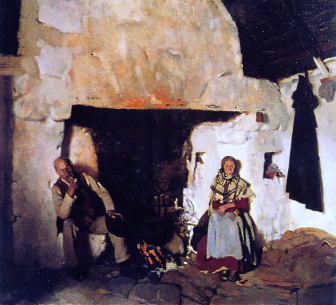
William Orpen’s Old John’s Cottage, Connemara, 1908-an unsentimental accurate observation. (Private collection, courtesy of Pym’s Gallery, London).
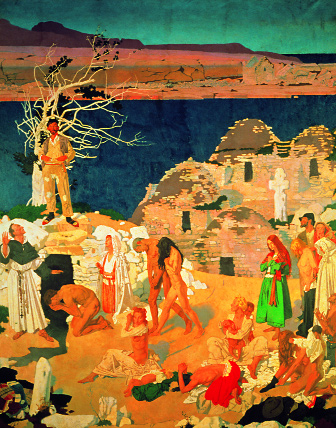
Orpen’s The Holy Well, 1916-an attempt to express the artist’s complex feelings about Ireland at the time of the Easter Rising. (National Gallery of Ireland, courtesy of the artist’s estate)
The political turmoil of this period led to the closure of the art school in 1923, along with the National Gallery, which did not reopen until 1924. Lamb had several teachers, all of whom had been taught by William Orpen during the period 1902-14, including Margaret Clarke, James Sleator, Patrick Tuohy and Sean Keating. The influence of Orpen and Keating was formative although Lamb was also very impressed with Tuohy, a republican artist who had fought in the GPO in 1916. Keating, who was Orpen’s main protégé, was the dominant personality at the school. He was a fervent nationalist and had made his first trip to the Aran Islands in 1914 at the suggestion of Harry Clarke, the stained glass artist. Throughout his life he spoke passionately to his students about the unique lifestyle in the West.
During his student years Lamb mixed in a group which included Pádraic Ó Conaire (1882-1928), a Galway poet and writer in Irish. A born storyteller, his stories such as M’Asal Beag Dubh were set in the Connemara Gaeltacht. Páidín Mháire told in simple sparse prose won him an Oireachtas prize in 1904. Ó Conaire and Lamb became firm friends with the writer becoming a mentor for the young artist, encouraging him to go and experience the folklore and language of Connemara. In autumn 1919 Lamb travelled to Galway, but was advised by Ó Conaire to go further west where he would find the clear open skies, unspoilt lifestyle and landscape that he was seeking.
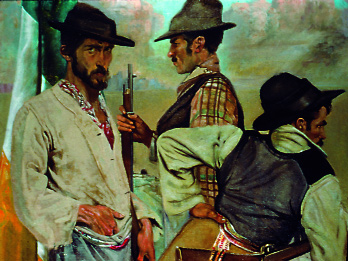
Sean Keating’s The Men of the West-a romantic work with its subjects portrayed as heroic figures. (Hugh Lane Municipal Gallery of Modern Art, Dublin, courtesy of the artist’s estate)
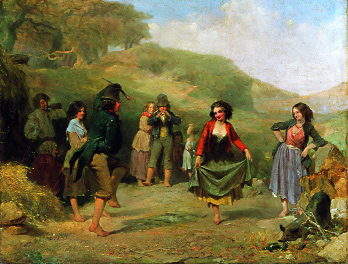
Trevor Fowler’s Children Dancing at a Crossroads-an identical subject viewed through mid-nineteenth-century eyes. (National Gallery of Ireland)
The artist’s son Peadar recalled his father saying that when he first visited Carraroe he was struck by the contrast it presented to the dark northern provincial town where he had grown up. It seemed like another world: clean, pure, simple and primitive; a haven of tranquillity. From that moment something in the artist’s psyche became anchored in Carraroe.
Not long after he first visited Carraroe, Lamb had an idea for a picture that would reflect the essence of life in Connemara. He had seen some of the portraits Orpen had based on western themes and he was particularly aware of pictures in which Keating was attempting to illustrate the developing national struggle. This was to be an ambitious work in which Lamb would attempt to convey an aspect of national identity using imagery drawn from the West of Ireland. These were uncertain times and students at art school were very conscious of the uneasy situation. Unrest and instability were an ongoing fact of life due to the War of Independence, the Treaty split, and the consequent civil war, which, by the time it ended in May 1923, left a legacy of bitterness for successive generations. While not particularly interested in politics, Lamb was well aware of the ongoing Troubles and knew at first hand that guerrilla warfare often caused ordinary people to become victims of terror and violence.
A tranquil social gathering
Despite the fact that Dancing at a Northern Crossroads dates to 1920, the most violent year in the War of Independence, Lamb’s quiet and romantic nature led him to portray a tranquil social gathering rather than the rousing images of men at war more associated with Keating. The artist was, however, conscious of the way continuous warfare was changing Irish life, so his concern was to record a pattern of life he felt was threatened.
Dancing at a Northern Crossroads is a genre picture representing a scene from the everyday life of the people of Connemara and recalls earlier paintings on the theme of the peasant. For instance, half a century earlier Trevor Fowler had depicted a similar subject, Children Dancing at the Crossroads (p.32), a typical nineteenth-century illustration of country dancing, and the Scottish artist Erskine Nicol, who visited Ireland between 1846 and 1850, had also painted this subject. Lamb’s knowledge of French painting, particularly the work of Édouard Manet, proved an asset. Dancing at a Northern Crossroads is full of life, the sound of the dancing, the music of the fiddle and the energy of the dancers’ movement. The composition is divided into three distinct groups: to the left a couple are seated, engaged in conversation; to the right there are three figures, one of whom leans over the wall smoking a pipe, the remaining two are seated on a grassy verge leaning against a stone wall watching the dancing; in the centre are four dancers and a fiddler. The style of the dancing is a bit of a puzzle since it is not recognisable as any particular set or a half-set and it is unlikely to be a céili dance. In the latter a waltz-hold would not have been allowed while in step dancing it would have been more customary for the dancers to keep their hands straight by their sides. It looks as though they are engaged in a form of set dancing, a common enough pastime at crossroads throughout the country. This type of informal gathering was also a way for young people to meet and enjoy themselves along with other activities such as pitch and toss. Such gatherings would sometimes take place while waiting for the bus to arrive or boats to bring turf and essential goods. The signpost, which has no placename, points due north, while the background reveals the rough stony terrain of Connemara.
Anomalies of costume
The picture incorporates a variety of figures wearing traditional, homespun costumes, including colourful patterned shawls, scarves and waistjackets. There are, however, some anomalies in the costume. It is unusual to find men wearing colourful outfits. The women, on the other hand, are wearing skirts with red petticoats at a time when it would have been more common for the red petticoats to have been worn on their own. The red waistjacket worn by the central figure is not of Connemara origin, where they were normally indigo, cream or brown; its source appears to be Lamb’s northern portraits such as The Lough Neagh Fisherman (p.33). Other items that do not quite fit include the striped shirts of the men, the large scale of the tartan and crocheted shawls and the white tops worn by the women. Costume was sometimes portrayed in a somewhat sketchy fashion as can be seen in Keating’s Men of the West and Orpen’s The Holy Well. At this early stage in Lamb’s career, however, it was difficult for the painter to be accurate about every detail of Connemara dress, and this is borne out by the composite form of dancing also portrayed in the picture. The artist was not yet familiar enough with western habits and customs to be aware of refinement of detail, and it must be remembered that the picture was composed and arranged in Dublin. In later works such as The Quaint Couple, 1930 (p.34), the artist’s eye had become more attuned to western dress and lifestyle.
Lamb spoke fondly about the painting to his children, indicating that he had taken time over the composition, particularly in making individual figure studies of small groups, weaving it together to form a coherent narrative. Throughout his life Lamb was interested in the works of J.M. Synge and it is not surprising that the mood and atmosphere of The Playboy of the Western World has much in common with Dancing at a Northern Crossroads. Synge was a romantic who wrote plays about specific events at a particular time: ‘The central incident of The Playboy was suggested to me by an actual occurrence in the west’—which the author then took and wove into a dramatic, violent play.
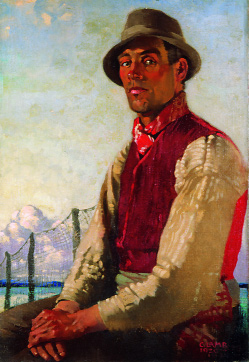
Lamb’s The Lough Neagh Fisherman-
In similar fashion Lamb identified a scene representing an everyday social gathering in Connemara which he translated into an arresting canvas. The Playboy strains between wild comedy and violent savagery, with scenes depicting social events such as pub life, sports activities and couples courting. The play could have been peopled by the figures depicted in Lamb’s picture. While the initial studies and idea for Dancing at a Northern Crossroads took place in Connemara, the picture is a studio work executed in Dublin. The majority of the figures who modelled for it were fellow art students of Lamb’s. The studies for the couple under the signpost, however, are drawn from Connemara people, while the figure of the dancer in the red waistjacket resembles the young man in The Lough Neagh Fisherman executed by Lamb that same year. Lamb’s picture displayed a level of confidence and ability that suggested the artist’s training was complete. The design was complex and well thought-out, the handling of the brushwork was assured and the picture was extremely well executed. The theme of national identity was very appropriate to the time and added to a growing number of Irish-subject pictures which attempted to articulate a new national consciousness. The artist realised that all the preparatory work and effort had proved worthwhile, that he had achieved his ambition with this picture, and in recognition of its personal value he priced it at £300.
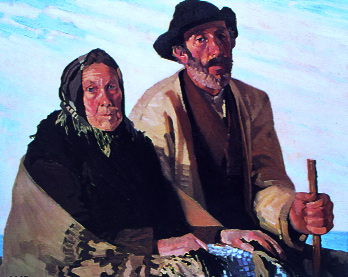
Lamb’s A Quaint Couple, 1930-by this time the artist’s eye had become more attuned to western dress and lifestyle. (Crawford Municipal Art Gallery, Cork, courtesy of the artist’s estate)
Dancing at a Northern Crossroads expresses an Irish subject in a serious and thoughtful manner. While writers and artists of the newly created Free State were searching for images to reflect an identity that linked back to an ancient Celtic past, their discovery of the innocent pastoral world of the West of Ireland provided just the material to develop a form of national identity. Lamb’s picture, like Synge’s plays, represents customs and traditions that helped form this sense of national consciousness.
Idealised view of life in Connemara
Yet while portraying a reasonably accurate and valuable record of past customs and traditions, it can also be seen as a somewhat idealised view of life in Connemara during the Troubles. The picture depicts robust and healthy people, with neat-fitting colourful costumes, and sturdy boots made of leather. Yet the reality of country life, particularly in Connemara, was much different. Life was hard during the 1920s with most people living an impoverished existence. Large families survived on smallholdings by farming poor, stony land. Clothes were patched and reused and most children went barefoot. People looked gaunt because they were tired and worn from struggling to survive. Emigration was the only hope for many western families. One of the ways people did amuse themselves was by walking to the local crossroads, a substitute for the village hall, to pass the evening away talking, dancing and listening to music.
However, issues other than the degree of realism in the painting are also important in order to achieve a deeper understanding of the work. Lamb was an art student during the 1920s, a time of political unrest and anarchy, when he was able to observe the effect of the Troubles on the daily lives of Dubliners and listen to the ongoing political debate. He was not a politically motivated person but it could be that the political and intellectual atmosphere of the time may have been enough to provoke him to create a work that he felt would identify with the emergent Free State. The artist may have had a struggle to articulate his feelings, only to find that his fascination with the western ideal provided the subject matter to create this work. The picture, therefore, proved to be his personal reaction to the troubled times whereas in later life he was never again moved in such a dramatic way. Mary Stinson Cosgrove has pointed out that Romantic myth and the modernist theory of subjectivity have managed to create the impression that art is above politics in Irish art history (Circa, no.52, 1990). In fact the images artists created in Ireland between 1916 and 1922 provide a fascinating response to developing political events, they illustrate artists and writers grappling with concepts of national consciousness and identity, and enhance and enrich our understanding of Irish history. This picture represents Lamb’s response.
Dancing at a Northern Crossroads proved to be the major work of Lamb’s early career. His early promise was sustained in a number of fine portraits, most notably The Quaint Couple, some beautiful works executed in 1926/7 in Brittany, also 1938/9 in Germany, and an impressive series of moody, windswept and atmospheric landscapes representing a lifetime of painting the length and breath of Connemara. By the time he was commissioned in 1934/5 to paint A Pattern Day in Connemara for University College Galway, his work had been shown at major exhibitions in London, Boston, New York, Brussels, Los Angeles and Chicago. He illustrated Cré na Cille by Máirtín Ó Cadhain in 1932, and An Tincéara Buí by Seán Ó Coisdealbha in 1962. From 1936 in Carraroe, he hosted an annual exhibition, and established a summer school of painting where he introduced generations of young artists to the delights and frustrations of painting landscape. It is fitting that when he died Lamb was buried at Barr an Doire in Carraroe.
Marie Bourke is the Keeper and Head of Education at the National Gallery of Ireland.
Further reading:
J. Sheehy, The Rediscovery of Ireland’s Past—The Celtic Revival 1830-1930 (London 1980).
K. McConkey, A Free Spirit, Irish Art 1860-1960 (London 1990).
M. Bourke, Charles Lamb RHA, Galway Paintings (Galway 1998).
M. Bourke & S. Bhreathnach Lynch, Discover Irish Art (Dublin 1999).
















